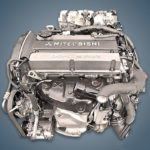The 2.0-liter Mitsubishi 4G94 engine was produced at a Japanese plant from 1999 to 2007 and was installed on a number of concern models until it was sold to Chinese companies in 2008. This unit was offered in two versions: SOHC with MPI multipoint injection system and DOHC with GDI direct injection.
In the Mitsubishi 4G9 family, the 2.0-liter 4G94 engine is the largest. This volume was achieved thanks to the installed crankshaft with a piston stroke of 95.8 mm, while the cylinder diameter expanded by only 0.5 mm.
The motor received hydraulic lifters, eliminating the need to constantly adjust valve clearances.
The 4G9 family also includes engines: 4G91, 4G92 and 4G93.
The engine was installed on:
- Mitsubishi Galant EA in 2000 – 2006;
- Mitsubishi Lancer CS in 2000 – 2007;
- Mitsubishi Pajero Pinin H67 in 1999 – 2007;
- Hawtai Santa Fe in 2009 – 2015.
Specifications
| Production years | 1999-2007 |
| Displacement, cc | 1999 |
| Fuel system | injector (MPI SOHC) direct injection (GDI DOHC) |
| Power output, hp | 125 (MPI SOHC) 145 (GDI DOHC) |
| Torque output, Nm | 176 (MPI SOHC) 191 (GDI DOHC) |
| Cylinder block | cast iron R4 |
| Block head | aluminum 16v |
| Cylinder bore, mm | 81.5 |
| Piston stroke, mm | 95.8 |
| Compression ratio | 9.5 (MPI SOHC) 11.0 (GDI DOHC) |
| Features | no |
| Hydraulic lifters | yes |
| Timing drive | belt |
| Phase regulator | no |
| Turbocharging | no |
| Recommended engine oil | 5W-30 |
| Engine oil capacity, liter | 3.8 |
| Fuel type | petrol |
| Euro standards | EURO 3 (MPI SOHC) EURO 4 (GDI DOHC) |
| Fuel consumption, L/100 km (for Mitsubishi Galant GDI 2002) — city — highway — combined |
10.5 6.3 7.8 |
| Engine lifespan, km | ~300 000 |
| Weight, kg | 150 |
Disadvantages of the Mitsubishi 4G94 engine
- Engine versions with GDi are demanding on fuel quality and cause a lot of trouble;
- A frequent breakdown of all modifications is the failure of hydraulic lifters;
- If the engine regularly stalls when hot, then most likely the idle control valve needs to be replaced;
- After 100 – 150 thousand kilometers, rings usually lie down and the oil burn begins;
- Due to the drop in oil pressure in the system, the risk of insert rotation increases.






